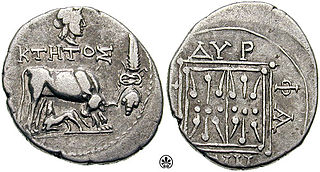 W
WThe Beauty of Durrës is a polychromatic mosaic of the 4th century BC and is the most ancient and important mosaic discovered in Albania. The 9 m2 (97 sq ft) mosaic is elliptical in shape and depicts a woman’s head on a black background, surrounded by flowers and other floral elements. It was discovered in 1918 in Durrës, and since 1982 has been on display at the National Historical Museum of Albania in Tirana.
 W
WDaorson was the capital of the Illyrian tribe of the Daorsi. The Daorsi lived in the valley of the Neretva River between 300 BC and 50 BC. They came very early into contact with Greek traders acquiring many facies of Greek civilization, and the town acquired a certain degree of Hellenization. The ruins of Daorson can be found at Ošanići, near Stolac, Bosnia and Herzegovina.
 W
WA Daunian stele is a type of stone funerary monument constructed by the Daunians, an Iapygian tribe which inhabited Apulia in classical antiquity. Daunian stelae were made from the end of the 8th century BC to the 6th century BC. They consist of a parallelepiped-shaped plate, which protrudes from the upper head and decorated on all four sides. Sizes vary between 40 and 130 cm in height, and consequently, between 20 and 80 cm in width while the thickness is between 3 and 12 cm.
 W
WDesilo is an underwater archaeological site in southern Bosnia and Herzegovina, located near the Neretva river and the Croatian border. The site was first discovered in the late 20th century, but Desilo's history can be traced as far back as ancient times. Investigations by a University of Mostar archaeological team in 2007 uncovered many sunken boats at the bottom of the small lake in Desilo valley. The archaeologists believe these boats to be Illyrian ships, dating back to the first and second centuries B.C. Further excavations in 2008 by University of Oslo archaeologists found evidence suggesting that Desilo was an Illyrian trading post. These archaeological findings are significant because they are the first known discovery of Illyrian ships. Additionally, Desilo functioning as a trading centre suggests there were peaceful interactions between the Illyrians and the Romans.
 W
WIllyrian coinage which began in the 6th century BC continued up to the 1st century of Roman rule. It was the southern Illyrians who minted the first coins followed by the northern Illyrian during the Roman era. Illyrian coins have also been found in other areas apart from Illyria, such ancient Macedonia, Italy, Greece, Asia Minor and Egypt.
 W
WIllyrian fibulae or brooches were widely used by Illyrians and were very common in Illyria. Some types of fibulae are one of the few objects that all of the Illyrians used and some are even used to declare the distribution of Illyrian people. Illyrians loved ornaments, and on festive occasions their womenfolk would appear heavily draped with all manner of jewellery. Several varieties of fibulae have a distinctive evolution in Ilyria, notable the Spectacle brooch of two concentrically wound spirals attached to the pin. The Glasinac fibula was a variant of the simple bow-fibula which is common among many Illyrians. Other forms which appear in the early Iron Age include those and with bosses on the arch, animal-shaped brooches, serpent-shaped and plate-brooches, the last being distinctively Liburnian.
 W
WThe Illyrian Tombs of Selca e Poshtme are located near the town of Pogradec in Albania near the village of Selcë e Poshtme. On the right bank of the river Shkumbin at an elevation of 1040 m above sea level, lie the remains of the ancient city of Pelion and the accompanying necropolis. The Roman Via Egnatia led past it towards Thessaloniki. Though there are traces of human activity in Neolithic times, the settlement proper dates to the Iron Age through to the Illyrian urban period, and reached its height under settlement by the Illyrian tribe of Enchele in the later Iron Age and was also occupied in the Roman period as traces of a municipal building show. From the 4th to 1st centuries BC the city was the royal residence of Illyrian kings and therefore, also probably an important political and economic centre. In 1996, Albania included the Royal tombs of Selca e Poshtme in the UNESCO World heritage list of proposals.
 W
WThe Soleto Map is a possibly ancient map depicting Salento and scratched onto a fragment of a terracotta pot. While the ostrakon itself is undoubtedly ancient, serious doubts have been raised about the age of the map.
 W
WThe spectacle brooch was an ancient fibula from the European Bronze Age. One form of the spectacle brooch originates from the Illyrians and consists of two concentrically wound spirals attached to a pin.
 W
WThe Vače Situla is an ornamented Early Iron Age ritual bronze vessel (situla) found in the second half of the 19th century at the Hallstatt Archaeological Site in Vače in central Slovenia. It counts among the highest-quality such vessels in general and among the most precious archeological artifacts of the country. Dating from the 5th century BC, it is considered to be one of the oldest situla objects of the northern Illyrians found in the Eastern Hallstatt zone. The vessel has three rows of relief that show the ordinary life of the ruling class and also reflect the religious understanding of the world in that time. It is on display in the National Museum of Slovenia.